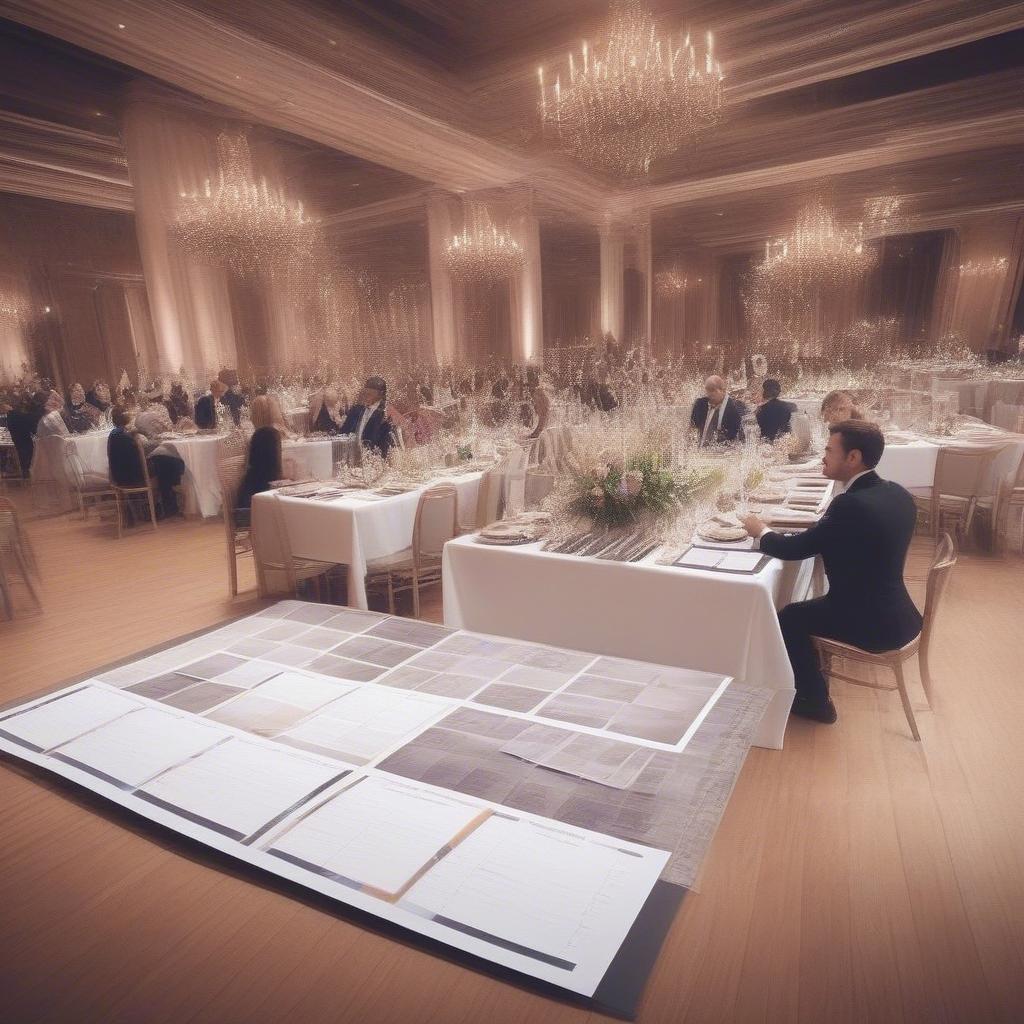
Embarking on the exciting journey of event planning? Whether you’re dreaming of orchestrating dazzling weddings, managing seamless corporate conferences, or throwing unforgettable birthday bashes, understanding the language of the industry is crucial. This guide demystifies the jargon, empowering you to confidently navigate the world of event planning. Consider this your cheat sheet, your translator, and your secret weapon for event planning success. So, let’s dive into the world of event planning terms!
Understanding the Foundation: Essential Event Planning Terms
Before we delve into the specifics, let’s establish a solid understanding of core event planning terminology. These are the building blocks upon which successful events are built.
1. Event Planning
What: Event planning is the process of designing, organizing, and executing events. It encompasses everything from initial concept development to post-event evaluation.
Why: The goal of event planning is to create a memorable and successful experience for attendees, achieving specific objectives for the host or client.
How: Event planning involves meticulous planning, budgeting, vendor management, logistics coordination, and on-site execution.
2. Event Management
What: Event management is the practical application of event planning. It focuses on the logistical aspects and on-site execution of the event.
Why: Event management ensures the smooth running of the event, addressing any unexpected challenges and ensuring attendee satisfaction.
How: Event management includes tasks such as venue setup, registration management, volunteer coordination, and troubleshooting during the event.
3. Request for Proposal (RFP)
What: An RFP is a document that outlines the requirements for an event and invites vendors to submit proposals outlining how they would meet those needs.
Why: RFPs allow event planners to compare different vendors and select the best options based on price, services, and experience.
How: The RFP typically includes details such as event scope, budget, timeline, and desired outcomes.
4. Contract
What: A legally binding agreement between the event planner (or client) and a vendor, outlining the terms and conditions of the services to be provided.
Why: Contracts protect both parties by clearly defining responsibilities, payment schedules, and cancellation policies.
How: Contracts should be reviewed by legal counsel to ensure they are fair and comprehensive.
5. Budget
What: A detailed financial plan that outlines all anticipated income and expenses related to the event.
Why: A budget helps track spending, prevent overspending, and ensure the event is financially viable.
How: The budget should include line items for venue rental, catering, entertainment, marketing, and contingency expenses.
6. Timeline
What: A schedule that outlines key milestones and deadlines for event planning tasks.
Why: A timeline ensures that all tasks are completed on time and that the event is launched smoothly.
How: The timeline should be realistic and allow for flexibility in case of unexpected delays.
7. Venue
What: The location where the event will take place.
Why: The venue sets the tone for the event and must be appropriate for the size, type, and style of the occasion.
How: Venue selection involves considering factors such as capacity, accessibility, amenities, and cost.
Event Design and Décor: Understanding Aesthetic Event Planning Terms
Now, let’s dive into the world of aesthetics and ambiance. Understanding these terms will help you articulate your vision and create truly memorable experiences.
8. Theme
What: The central idea or concept that unifies all aspects of the event’s design and execution.
Why: A theme creates a cohesive and engaging experience for attendees.
How: A theme can be based on a color scheme, historical period, pop culture phenomenon, or any other unifying element.
9. Décor
What: The decorative elements used to enhance the ambiance of the event space.
Why: Décor transforms the venue and creates a specific mood or atmosphere.
How: Décor can include floral arrangements, lighting, linens, furniture, and signage.
10. Centerpiece
What: A decorative item placed in the center of a table, often a floral arrangement or sculpture.
Why: Centerpieces add visual interest and enhance the overall aesthetic of the table setting.
How: Centerpieces should be appropriate for the style and theme of the event.
11. Backdrop
What: A decorative background used to create a focal point for photos or presentations.
Why: Backdrops provide a visually appealing backdrop for event activities and photos.
How: Backdrops can be made from fabric, paper, balloons, or other materials.
12. Lighting
What: The use of light to create a specific mood or atmosphere.
Why: Lighting can dramatically transform a venue and enhance the overall event experience.
How: Lighting techniques include uplighting, spotlighting, and color washes.
13. AV (Audio Visual)
What: Refers to the equipment and technology used for audio and visual presentations.
Why: AV equipment is essential for delivering impactful presentations and entertainment.
How: AV equipment includes projectors, screens, microphones, speakers, and lighting systems.
14. Floor Plan
What: A diagram that shows the layout of the event space, including the placement of tables, chairs, stage, and other elements.
Why: A floor plan ensures that the event space is utilized efficiently and that attendees can move around comfortably.
How: Floor plans can be created using specialized software or by hand.
Event Catering and Food Service: Culinary Event Planning Terms
Food is a critical element of any successful event. Mastering these catering terms will help you create a delicious and memorable dining experience.
15. Catering
What: The provision of food and beverages for an event.
Why: Catering ensures that attendees are well-fed and hydrated, enhancing their overall experience.
How: Catering can range from simple snacks and beverages to elaborate multi-course meals.
16. Menu
What: A list of food and beverages that will be served at the event.
Why: The menu should be tailored to the event’s theme, budget, and dietary restrictions.
How: The menu can include appetizers, entrees, desserts, and beverages.
17. Dietary Restrictions
What: Specific limitations on what attendees can eat due to allergies, religious beliefs, or personal preferences.
Why: It’s essential to accommodate dietary restrictions to ensure that all attendees can enjoy the food.
How: Common dietary restrictions include vegetarian, vegan, gluten-free, and dairy-free.
18. Plated Meal
What: A meal served to each guest individually, with the food already arranged on the plate.
Why: Plated meals are a formal dining option that is often used for weddings and corporate events.
How: Plated meals require more staff and preparation than buffet service.
19. Buffet
What: A self-service dining option where guests select food from a variety of dishes.
Why: Buffets are a more casual dining option that is often used for larger events.
How: Buffets require less staff than plated meals and allow guests to customize their meals.
20. Hors d’oeuvres
What: Small, bite-sized appetizers served before a meal.
Why: Hors d’oeuvres provide guests with something to eat while they mingle before the main event.
How: Hors d’oeuvres can be served hot or cold.
21. Open Bar
What: A bar where guests can drink without paying for each individual drink.
Why: Open bars are a popular option for weddings and corporate events.
How: The host typically pays a flat fee per guest or a set amount for all beverages consumed.
Event Technology and Marketing: Modern Event Planning Terms
In the digital age, technology and marketing are integral to event success. These terms will help you leverage the latest tools and strategies.
22. Event Website
What: A website dedicated to providing information about the event.
Why: Event websites are essential for promoting the event, registering attendees, and providing important details.
How: Event websites should include information such as date, time, location, agenda, speakers, and registration details.
23. Social Media Marketing
What: The use of social media platforms to promote the event.
Why: Social media marketing can reach a large audience and generate buzz around the event.
How: Social media marketing strategies include creating event pages, posting engaging content, and running targeted ads.
24. Email Marketing
What: The use of email to communicate with potential and registered attendees.
Why: Email marketing is an effective way to promote the event, send reminders, and provide important updates.
How: Email marketing campaigns should be targeted and personalized.
25. Event App
What: A mobile application designed specifically for the event.
Why: Event apps can enhance the attendee experience by providing access to information, schedules, maps, and networking opportunities.
How: Event apps can be customized to meet the specific needs of the event.
26. Registration System
What: A software system used to manage attendee registration.
Why: Registration systems streamline the registration process, collect attendee data, and manage payments.
How: Registration systems can be integrated with event websites and mobile apps.
27. Live Streaming
What: Broadcasting the event live over the internet.
Why: Live streaming allows people who cannot attend the event in person to participate remotely.
How: Live streaming requires specialized equipment and software.
Event Logistics and Operations: Behind-the-Scenes Event Planning Terms
The smooth execution of an event depends on meticulous logistics and operations. Understanding these terms will ensure that everything runs like clockwork.
28. Load-In/Load-Out
What: The process of bringing equipment and materials into the venue (load-in) and removing them after the event (load-out).
Why: Efficient load-in and load-out processes are essential for staying on schedule and minimizing disruption.
How: Load-in and load-out require careful planning and coordination with venue staff and vendors.
29. Run of Show (ROS)
What: A detailed schedule that outlines the sequence of events, including timings, speakers, and activities.
Why: The ROS ensures that the event stays on track and that all participants know what to expect.
How: The ROS should be distributed to all key stakeholders before the event.
30. Contingency Plan
What: A plan that outlines how to handle unexpected problems or emergencies.
Why: A contingency plan ensures that the event can continue smoothly even in the face of challenges.
How: Contingency plans should address potential problems such as bad weather, power outages, and security threats.
31. On-Site Management
What: The coordination and supervision of all activities during the event.
Why: On-site management ensures that the event runs smoothly and that any problems are addressed promptly.
How: On-site management requires strong leadership, communication, and problem-solving skills.
32. Post-Event Evaluation
What: The process of reviewing the event’s successes and failures to identify areas for improvement.
Why: Post-event evaluation helps improve future events and demonstrate the value of event planning efforts.
How: Post-event evaluation can involve gathering feedback from attendees, analyzing event data, and reviewing financial results.
33. BEO (Banquet Event Order)
What: A detailed document outlining all aspects of a catered event, including menu, setup, and timeline, shared between the event planner and the venue/caterer.
Why: The BEO serves as a crucial communication tool, ensuring everyone is on the same page regarding the event’s logistics and requirements.
How: The BEO is typically created collaboratively, finalized, and signed off by all parties involved.
Specific Event Types: Event Planning Terms for Different Occasions
Event planning isn’t one-size-fits-all. Different types of events have specific terms associated with them.
34. Weddings
- Save-the-Date: A preliminary notification sent to guests well in advance of the wedding invitation.
- RSVP: A response from a guest indicating whether or not they will attend the wedding.
- Seating Chart: A diagram showing the seating arrangement for the wedding reception.
- Bridesmaid/Groomsman: Members of the wedding party who support the bride and groom.
35. Corporate Events
- Trade Show: An exhibition where companies in a specific industry showcase their products and services.
- Conference: A meeting where people gather to discuss a specific topic.
- Seminar: A presentation or workshop on a specific topic.
- Networking Event: An event designed to facilitate connections between attendees.
36. Fundraisers
- Silent Auction: An auction where bids are submitted in writing.
- Gala: A formal fundraising event with dinner and entertainment.
- Sponsorship: Financial support provided by a company or individual in exchange for recognition.
- Donation: A gift of money or goods to a non-profit organization.
Industry Jargon: Decoding Common Event Planning Terms
Beyond the basics, event planning has its own unique slang and abbreviations.
37. FAM Trip
What: A familiarization trip offered to event planners and potential clients to showcase a venue or destination.
Why: FAM trips allow planners to experience the venue firsthand and assess its suitability for their events.
How: FAM trips are typically all-expenses-paid and include tours, meals, and activities.
38. B2B (Business-to-Business)
What: Events that focus on networking and business development between companies.
Why: B2B events are designed to generate leads, build relationships, and promote industry collaboration.
How: B2B events often include trade shows, conferences, and networking sessions.
39. ROI (Return on Investment)
What: A measure of the financial benefits of an event compared to the costs.
Why: ROI is used to evaluate the success of an event and justify event planning expenses.
How: ROI can be calculated by dividing the net profit of the event by the total cost.
40. Green Event
What: An event that is planned and executed in an environmentally responsible manner.
Why: Green events minimize the environmental impact of events and promote sustainability.
How: Green events can incorporate practices such as using recycled materials, reducing waste, and conserving energy.
41. Hybrid Event
What: An event that combines both in-person and virtual elements, allowing attendees to participate both physically and remotely.
Why: Hybrid events offer increased accessibility and reach, allowing organizers to engage a wider audience.
How: Hybrid events often involve live streaming, virtual platforms, and interactive elements that connect in-person and online attendees.
Learn Business: Your Partner in Event Planning Success
Understanding event planning terminology is just the first step. To truly excel, you need the right tools, strategies, and guidance. That’s where Learn Business comes in.
Learn Business supports aspiring and established event planners by offering a wealth of resources, including:
- Business Plan Templates: Start your event planning business with a solid foundation.
- Marketing Plan Templates: Attract clients and build your brand.
- Financial Templates: Manage your finances effectively and track profitability.
- Event Planning Checklists: Ensure no detail is overlooked in the planning process.
- Contract Templates: Protect your business and clients with legally sound agreements.
- Event Budget Templates: Effectively manage and plan event budget.
- Event Proposal Templates: Creating compelling event proposals.
Learn Business provides the practical tools and expert guidance you need to navigate the complexities of event planning and achieve your business goals. Visit Learn Business today to unlock your event planning potential.
By mastering the language of event planning and leveraging the resources available through Learn Business, you’ll be well-equipped to create unforgettable experiences and build a successful event planning career. So, embrace the journey, keep learning, and get ready to plan your way to the top! Remember that continuous learning and adapting to new trends are crucial in the dynamic world of event planning. Now that you are equipped with a comprehensive glossary of event planning terms, you’re ready to confidently navigate the field and turn your event planning dreams into reality. Happy planning!



Leave a Reply